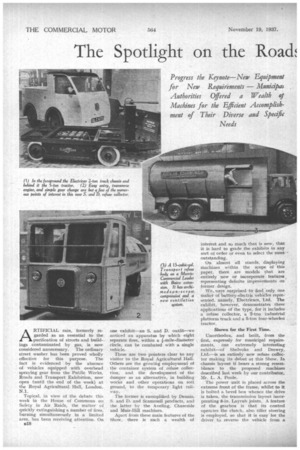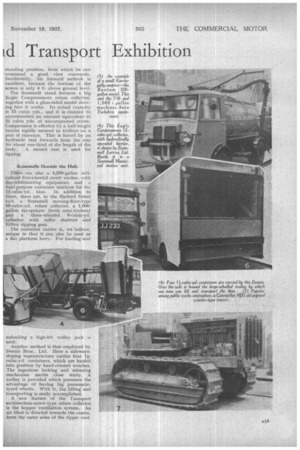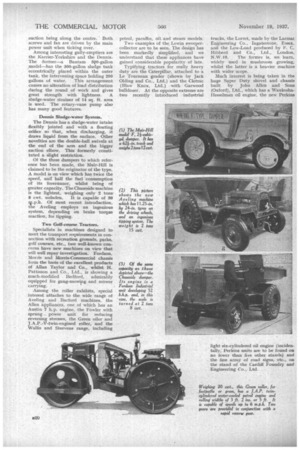The Spotlight on the Roacb id Transport Exhibition
Page 20

Page 21

Page 22

If you've noticed an error in this article please click here to report it so we can fix it.
Progress the Keynote—New Equipment for New R.equirements — .Municipa; Authorities Offered a Wealth Machines for the Efficient Accomplishment of Their Diverse and Specific
ARTIFICIAL rain, formerly regarded as an essential to the purification of streets and buildings contaminated by gas, is now considered unnecessary. The ordinary street washer has been proved wholly effective for this purpose. The fact is evidenced by the absence of vehicles equipped with overhead spraying gear from the Public Works, Roads and Transport Exhibition, now open (until the end of the -week) at the Royal Agricultural Hall, London, Ni.
Topical, in view of the debate this week in the House of Commons on Safety in Air Raids, the matter of quickly extinguishing a number of tires, burning simultaneously in a limited area, has been receiving attention, On 1318 one exhibit—an a and D. outfit—we noticed an apparatus by which eight separate fires, within a i-mile-diaineter circle, can be combated with a single • vehicle.
These are two pointers clear to any visitor to the Royal Agricultural Hall. Others are the growing employment of the container system of refuse collection, and the development of the dumper as an alternative, in building works and other operations on soft ground, to the temporary light railway.
The former is exemplified by Dennis, S. and D. and ScammelI products, and the latter by the Aveling. Chaseside and Muir-Hill machines.
Apart from these main features of the Show, there is such a wealth of interest and so much that is new, that it is hard to grade the exhibits in any sort of order or even to select the most outstanding.
On almost all stands, displaying
machines within the scope of this paper,' there are models that are entirely new or incorporate features representing definite improvements on former design.
'We., tvere surprised to find, only one makerof battery -electric vehicles represented, namely, Eleetricars, Ltd. The exhibit, however, demonstrates three applications of the type, for it includes a refuse collector, a 2-ton industrial platform truck and a 5-ton four-wheeled tractor.
Shown for the First Time.
Unorthodox, and built, from the first, expressly for municipal requirements, one extremely interesting exhibit—of Shelvoke and Drewry. Ltd.—is an entirely new refuse collector making its debut at this Show. In chassis layout it bears a strong resentblance to the proposed machines described last week by our contributor, Mr. L. A. Poole.
The power unit is placed across the extreme front of the frame; whilst to it is bolted a bevel box whence the drive is taken, the transmission layout incorporating 8-in. Layruh joints, A 'feature of the gearbox is that its control operates the clutch, also tiller 'steering is employed, so that it is easy for the. driver to reverse the vehicle from a
standing position, from which he can command a good view rearwards. Incidentally, his forward outlook is excellent, because the bottom of the screen is only 4 ft. above ground level.
The Scammell stand features a big Eagle Compressmore refuse collector, together with a glass-sided model showing how it works. Its actual capacity is 15 cubic yds., and it is claimed to accommodate an amount equivalent to 24 cubic yds. of uncompressed refuse. Compression is effected by a half-height barrier rigidly secured to trolleys on a pair of runways. This is forced by an hydraulic ram forwards from the rear for about one-third of the length of the body. A second ram is used for tipping.
Scammelis Outside the Hall.
There are also a 1,200-gallon articulated five-wheeled street washer, with decontaminating equipment, and a dual-purpose container machine fcir teu .14-cubic-yd. bins. In addition to these, there are, in the Barford Street exit, a Scammell moving-floor-type 1S-cubic-yd. refuse collector, a 1,000gallon tar-sprayer (both semi-trailers) anda three-wheeled 6-cubic.-yd. collector with roller shutters and Etibro tipping gear.
The container carrier is, we believe, unique in that it can also be used as a flat platform lorry. For loading and unloading a high-lift trolley jack Is used.
Another method is that employed by Dennis Bros., Ltd. Here a sideways
sloping superstructure carries four cubic-yd containers, which are hauled into position by hand-rotated winches. The ingenious locking and releasing mechanism merits close study. A trolley is provided which possesses the advantage of having big pneumatictyred wheels. With it, bin lifting' and transporting is easily accomplished.
A new feature of the Transport archimedean-screw-type refuse collector is the hopper ventilation system. An air blast is directed towards the centre, from the outer sides of the tipper roof. suction being along the centre. Both screws and fan are driven by the main power unit when ticking over.
Among interesting gully-emptiers are the Karrier-Yorkshire and the Dennis. The former—a Bantam 590-gallon model—has the 300-gallon sludge tank eccentrically placed within the outer tank, the intervening space holding 200 gallons of water. This arrangement causes no alteration of load distribution during the round of work and gives great strength with lightness. A sludge-water strainer of 14 sq. ft. area is used. The rotary-vane pump also has many good features.
Dennis Sludge-water System.
The Dennis has a sludge-water intake flexibly jointed and with a floating orifice so that, when discharging, it draws liquid from the surface. Other novelties are the double-ball swivels at the end of the arm and the bigger suction elbow. This formerly constituted a slight restriction.
Of the three dumpers to which reference has been made, the Muir-Hill is claimed to be the originator of the type. A model is on view which has twice the speed, and half the fuel consumption of its forerunner, whilst being of greater capacity. The Chaseside machine is the lightest, weighing only 2 tons 8 cwt. unladen. It is capable of 30 Of most recent introduction, the Aveling employs an ingenious system, depending on brake torque reaction, for tipping.
Two Golf-course Tractors.
Specialists in machines designed to meet the transport requirements in connection with recreation grounds, perks, golf courses, etc., two well-known concerns have new machines on view that will well repay investigation. Fordson, Morris and Morris-Commercial chassis form the basis of the excellent products of Allan Taylor and Co., whilst H. Pattisson and Co., Ltd., is showing a much-modified Bedford, admirably equipped for gang-mowing and mower • carrying.
Among the roller exhibits, special interest attaches to the wide range of Aveling and Barford machines, the Allen appliances, one of which has an Austin 7 h.p. engine, the Fowler with sprung power unit for reducing reversing stresses, the Green oiler and J.A.P.-17-twin-enginet1 roller, and the Wallis and Steevens range, including petrol, paraffin, oil, and steam models.
Two examples of the Lewin sweepercollector are to be seen. The design has been markedly simplified, and we understand that these appliances have gained considerable popularity of late.
Typifying tractors for really heavy duty are the Caterpillar, attached to a Le Tourneau grader (shown by Jack Olding and Co., Ltd.) and the Cletrae (Blaw Knox, Ltd.) with •Garwood bulldozer. At the opposite extreme are two recently introduced industrial trucks, the Lorret, made by the Larrnar Engineering Co., Ingatestone, and the Low-Load produced by F. C. Hibberd and Co., Ltd., London, N.W.10. The former is, we learn, widely used in mushroom growing, whilst the latter is a heavier machine with wider scope.
Much interest is being taken in the huge Suer Duty shovel and chassis built by John Allen and Sons (Oxford), Ltd., which has a WaukeshaIfesselman oil engine, the new Perkins




























